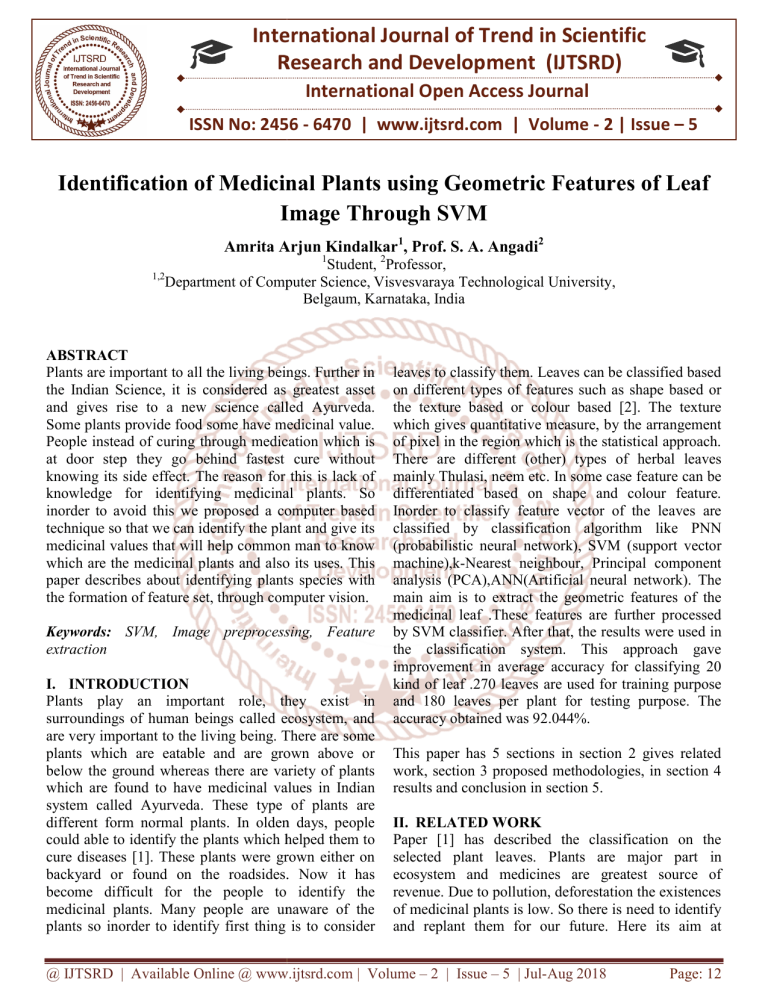
International Journal of Trend in Scientific
Research and Development (IJTSRD)
International Open Access Journal
ISSN No: 2456 - 6470 | www.ijtsrd.com | Volume - 2 | Issue – 5
Identification off Medicinal P
Plants using
sing Geometric Features of
o Leaf
Image Through S
SVM
Amrita Arjun Kindalkar1, Prof. S. A. Angadi2
1
1,2
Student, 2Professor,
Department of Computer
omputer Science, Visvesvaraya Technological University,
University
Belgaum, Karnataka, India
ABSTRACT
Plants are important to all the living beings. Further in
the Indian Science, it is considered as greatest asset
and gives rise to a new science calle
called Ayurveda.
Some plants provide food some have medicinal value.
People instead of curing through medication which is
at door step they go behind fastest cure without
knowing its side effect. The reason for this is lack of
knowledge for identifying medicina
medicinal plants. So
inorder to avoid this we proposed a computer based
technique so that we can identify the plant and give its
medicinal values that will help common man to know
which are the medicinal plants and also its uses. This
paper describes about identifying
ying plants species with
the formation of feature set, through computer vision.
Keywords: SVM, Image preprocessing, Feature
extraction
I. INTRODUCTION
Plants play an important role, they exist in
surroundings of human beings called ecosystem, and
are very important to the living being. There are some
plants which are eatable and are grown above or
below the ground whereas there are variety of plants
whichh are found to have medicinal values in Indian
system called Ayurveda. These type of plants are
different form normal plants. In olden days, people
could able to identify the plants which helped them to
cure diseases [1]. These plants were grown either on
backyard or found on the roadsides. Now it has
become difficult for the people to identify the
medicinal plants. Many people are unaware of the
plants so inorder to identify first thing is to consider
leaves to classify them. Leaves can be classified based
on different types of features such as shape based or
the texture based or colour based [2]. The texture
which gives quantitative measure, by the arrangement
of pixel in the region which is the statistical approach.
There are different (other) types of herbal leaves
mainly Thulasi, neem etc. In some case feature can be
differentiated based on shape and colour feature.
Inorder to classify feature vector of the leaves are
classified by classification algorithm like PNN
(probabilistic neural network), SVM (support
(
vector
machine),k-Nearest
Nearest neighbour, Principal component
analysis (PCA),ANN(Artificial neural network). The
main aim is to extract the geometric features of the
medicinal leaf .These features are further processed
by SVM classifier. After that, the results were used in
the classification system. This approach gave
improvement in average accuracy for classifying 20
kind of leaf .270 leaves are used for training purpose
and 180 leaves per plant for testing purpose. The
accuracy obtained was 92.044%.
This paper has 5 sections in section 2 gives related
work, section 3 proposed methodologies, in section 4
results and conclusion in section 5.
II. RELATED WORK
Paper [1] has described the classification on the
selected plant leaves. Plants are major part in
ecosystem and medicines are greatest source of
revenue. Due to pollution, deforestation the existences
of medicinal plants is low. So there is need to identify
and replant them for our future. Here its aim at
@ IJTSRD | Available Online @ www.ijtsrd.com | Volume – 2 | Issue – 5 | Jul-Aug
Aug 2018
Page: 12
International Journal of Trend in Scientific Research and Development (IJTSRD) ISSN: 2456-6470
implementing the leaf image using image processing.
This software should give the closest match to the
query. The proposed algorithm is implemented and
the efficiency of the system is found by testing it on
10 different plant species. The software is trained with
100 leaves and tested with 50 leaves. The efficiency
of the 92% is found.
Paper [2] describes about the plants and which are the
other kind of feature that can be extracted of leaves.
This paper also gives description of various kinds of
classifiers that can used for the training and for testing
purpose to get the final result.
the number of white or '1' pixels
Perimeter: number (count)of pixel in the leaf margin.
Paper [3] describes on identification of plants leaf by
their shaped based and neural network as classifier.
The plants types are analyzed by using different shape
techniques such as moment invariant and other
centriod radii model, where this system gives a quick
and efficient classification of plants species.
Classifier: The dataset of the leaf stored in the
database is trained and tested by the classifier.
III. PROPOSED METHODOLOGY
Major axis length: The line segment joining the
lowest point and tip of leaf is the major axis.
Minor axis length: The maximum width, which is
perpendicular to the major axis, is the minor axis of a
leaf.
Bounding box: It gives the height and width of the
leaf
Support vector machine: It is one type of classifier
used in training and testing process. It performance in
multi dimensional space and which is efficient. It map
the non- linear to high dimensional and separating the
linear data.
Fig.3.1 Architecture design
Pre-processing:
The input is taken as the image of the leaf. In this
step, it removes if there present any external noise in
image. The main idea is to find the clear image so that
it can be further processed. Then it is converted into
grayscale from the color image, which is easy for the
extraction. By using the edge detector contour of the
leaf is identified.
IV. RESULTS
In the experiments, we used our own dataset by
collecting medicinal leafs images. The leaves are
captured using the digital camera and set the database.
It has 20 medicinal species, atleast 10 samples per
species and a total of 450 samples. The sample
features are shown in table1
Feature extraction:
Each leaf has its own feature it can be either shape or
its color or texture.
Shape features:
It can be recognized by types of shape based on
geometrical feature of leaves.
Area: Area is the number of pixels in the fix space or
the region. The area of leaf in a segmented image is
Figure 4.1 Input Colocasia leaf and boundary detected
image
@ IJTSRD | Available Online @ www.ijtsrd.com | Volume – 2 | Issue – 5 | Jul-Aug 2018
Page: 13
International Journal of Trend in Scientific Research and Development (IJTSRD) ISSN: 2456-6470
LEAF
Colocasia
Insulin
Keratin
Neem
Tulsi
Hisbiscus
Leamon
Methi
Pepper
Betel
Periwinkle
Kepulu
Hogplum
Curry
Peelikaner
Sambrani
Milkweed
Panikoorka
Parijath
Surpin
Table.1 Feature set for some of the medicinal leaf
Area
Perimeter Major Minor
Bounding box
15848.00
34240.00
6753.00
2398.00
3473.00
8639.00
61599.00
5526.00
54555.00
43230.00
17680.00
573.00
9948.00
1435.00
9192.00
2762.00
24625.00
28103.00
28383.00
9918.00
504.48
794.33
420.35
241.54
261.09
3639.00
1007.70
317.35
298.17
872.22
551.64
204.14
532.24
151.00
801.47
199.98
663.92.
732.18
730.19
613.41
184.70
319.75
166.86
96.03
84.93
724.99
368.80
122.38
298.17
312.19
210.24
99.14
265.84
61.23
398.85
69.32
281.32
219.73
236.00
166.61
112.46
138.74
53.54
33.53
55.07
90.32
213.81
59.09
237.54
184.6
107.88
13.65
79.35
30.42
35.96
52.59
113.58
169.74
160.99
90.92
120.00,203.00
150.0, 342.00
1.00 ,1.00
104.00, 51.00
97.00,62.00
95.00,143.00
222.00,406.00
137.00,63.00
308.00,234.00
197.00,354.00
145.00,200.00
14.00,35.00
86.00,167.00
31.00,62.00
157.00,363.00
8.00,33.00
120.00,285.0
1.00,1.00
2.00,3.00
192.00,123.00
area, perimeter, major axis, minor axis, bounding box
etc . It is matched with the input given by the user and
gives the geometric feature of that particular leaf.
The proposed methodology helps in identifying the
medicinal plants by processing its leaf image. Further
the system also displays the medicinal features of the
plants. The system will help in automate the
traditional knowledge regarding the medicinal values
of plants.
REFERENCES
Fig4.2 ROC graph
Here we have used 270 leaves for training and 180
leaves for testing. Finally recognition of medicinal
plants using SVM is carried out and is plotted as an
ROC graph. The average recognition accuracy
obtained is about 92.044%
V. CONCLUSION
As plants are important for all the living beings the
leaves of the plants help us to cure disease. Here
different leaves are been trained and stored in
database where it calculate the feature set such has
1. A Gopal, S. Prudhveeswar Reddy and V. Gayatri”
Classification for selected medicinal plants leaf
using image processings” in proceeding
International Conference on Machine Vision and
Image Processing (MVIP),2012. .
2. Sapna Sharma, Dr. Chitvan Gupta “A Review of
the Plants Recognition Methods and Algorithms”
,International Journal of Innovative Research in
Advanced Engineering (IJIRAE) ISSN: 23492163 Issue 6 Volume 2 (June 2015)
3. Jyotismita Chaki, Ranjan Parekh “Plant Leaf
Recognition by using Shape based Features and
Neurals Networks classifiers”
International
@ IJTSRD | Available Online @ www.ijtsrd.com | Volume – 2 | Issue – 5 | Jul-Aug 2018
Page: 14
International Journal of Trend in Scientific Research and Development (IJTSRD) ISSN: 2456-6470
Journal of Advanced Computer Science &
Application, (IJACSA) Vol. 2, No. 10, 2011
4. A. Kadir et al.” Performance Improvement of the
Leaf Identification System By Using Principal
Component Analysis”, Internationals Journals of
Advanced Sciences and Technology Vol. 44, July,
2012
5. Shitala Prasad, Krishna Mohan Kudiri, & R.C.
Tripathi ,” Relative Sub-Image Based Features for
the Leaf Recognitions by using Support Vector
Machine ”, in Proceedings International
Conference on Communication, Computing and
security ,Pages 343-346 , 2013.
6. Anami, Basavaraj S, S. Nandyal Suvarna, & A.
Govardhan. "A combined color, texture & edge
features based on approach for identification and
classifications of Indian Medicinal plants."
International Journal of Computer Applications,
page. 45-51, 2010.
7. Jamil N, Hussin NA, Nordin S & Awang K.
“Automatic Plants Identification: Is Shape the Key
Feature?” Procedia Computer Science, vol.74,
Pages.36-42, December 2015
8. A Gopal, S. Prudhveeswar Reddy & V. Gayatri,”
Classifications of the selected medicinal plants
leaf using image processing”, in proceedings
International Conference on Machine Vision and
Image Processing (MVIP),2012.
9. R. Janani, A. Gopal,” Identifications of the
selected medicinal plants leaf using Image
Features and ANN", in proceedings International
Conference on Electronic Systems, 2013.
10. Meeta, K., K. Mrunali, P. Shubhada, P. Prajakta,
& B. Neha "Survey on techniques for plant leaf
classification." International Journal of Modern
Engineering Research (IJMER) Vol no. 2,
Pages.538-544, 2012.
@ IJTSRD | Available Online @ www.ijtsrd.com | Volume – 2 | Issue – 5 | Jul-Aug 2018
Page: 15





